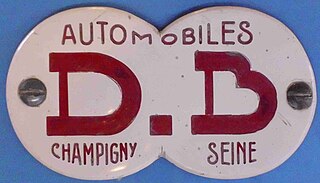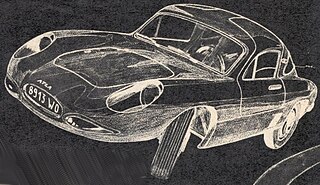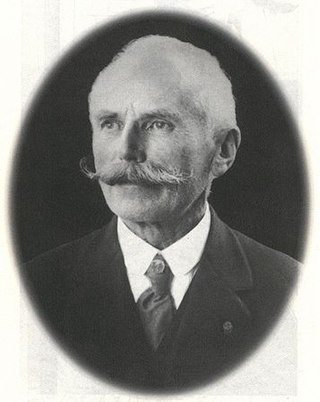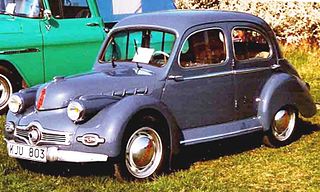
Deutsch-Bonnet (DB), is a brand of sports cars created in 1937 by Charles Deutsch and René Bonnet and disappeared in 1962.

Chappe et Gessalin is the short-form of the name of French coachbuilder "Carrosserie Chappe Frères et Gessalin". The company built automobile bodies and did contract assembly for other automobile manufacturers. It was also the parent of Automobiles CG, a French automobile maker founded in 1966 which built and sold complete cars under its own name.

Simca was a French automaker, founded in November 1934 by Fiat S.p.A. and directed from July 1935 to May 1963 by Italian Henri Pigozzi. Simca was affiliated with Fiat and, after Simca bought Ford's French subsidiary, became increasingly controlled by Chrysler. In 1970, Simca became a brand of Chrysler's European business, ending its period as an independent company. Simca disappeared in 1978, when Chrysler divested its European operations to another French automaker, PSA Peugeot Citroën. PSA replaced the Simca brand with Talbot after a short period when some models were badged as Simca-Talbots.

Panhard was a French motor vehicle manufacturer that began as one of the first makers of automobiles. It was a manufacturer of light tactical and military vehicles. Its final incarnation, now owned by Renault Trucks Defense, was formed by the acquisition of Panhard by Auverland in 2005, and then by Renault in 2012. In 2018 Renault Trucks Defense, ACMAT and Panhard combined under a single brand, Arquus.

The Atla is a French automobile that was manufactured from 1957 to 1959 in the commune of Garches in the western suburbs of Paris.

The Panhard Dyna Z is a lightweight motor car produced by Panhard of France from 1954 to 1959. It was first presented to the press at a Paris restaurant named Les Ambassadeurs on 17 June 1953 and entered production the following year. In 1959, it was replaced by the Panhard PL 17.

Arthur Constantin Krebs was a French officer and pioneer in automotive engineering.

The Panhard PL 17 is an automobile made by the French manufacturer Panhard from 1959 until 1965. Presented on 29 June 1959, as successor to the Panhard Dyna Z, the PL 17 was essentially a facelifted version of its predecessor. The initial four-door saloon was joined by the Cabriolet in 1961, and by the Break, a five-door estate version, in April 1963. The Break, developed by Italian company Pan Auto, sat on a longer wheelbase but was of the same overall length.

Brewster & Company was an American custom carriage and motorcar coachbuilder. James Brewster established the company in 1810 which operated for approximately 130 years. Brewster got its start in New Haven, Connecticut, and quickly gained a reputation for producing the best carriages in the country. In 1827, he set his shop at 52 Broad Street in New York City.

The Panhard Dyna X was a lightweight berline designed by the engineer Jean Albert Grégoire and first exhibited as the AFG (Aluminium Français Grégoire) Dyna at the Paris Motor Show in 1946.

Clément-Panhard is an automobile designed in 1898 by Arthur Constantin Krebs, manager of Panhard & Levassor co, from his 1896 patent of a car fitted with an electromagnetic gearbox, whose licence was acquired by Émile Levassor.
Paul-Marie Pons was a French naval engineer who became a senior civil servant. He is remembered for the Pons Plan which restructured the French automotive industry in the second half of the 1940s.
Jacques Durand was a French engineer, model builder and automobile designer. He is primarily known for designing several sports cars, which were built in small volumes in France beginning in the 1950s and continuing into the 1990s.

The Panhard CD is a car designed by Charles Deutsch and built by Panhard from 1963 to 1965. The CD was named for Deutsch and is considered a continuation of the line of Panhard-powered vehicles built by Deutsch-Bonnet. The car was the production version of the CD Dyna that raced at Le Mans in June 1962.

The Panhard Dyna Junior is a small sports car built by Panhard from 1952 until 1956. The car was initially offered as a roadster and later as a cabriolet. Slightly over 4,700 were built.
Établissements Monopole was a French manufacturing company that produced parts for automobile engines. The company also built and raced a series of small displacement endurance racing cars. After a series of mergers and acquisitions the Monopole name was retired in Europe, but survives in Africa in the name of a former licensee.
Albert Marie Louis Delagarde (1898–1990) was an engineer and automotive designer known primarily for his work with French carmaker Panhard & Levassor.
René Ducassou-Péhau was a French automobile designer. He was born in Basque country, and died in Labourd. He is best known for his work with car manufacturer Panhard.
Louis Bionier (1898–1973) was a French automotive engineer. He is best known as head of chassis development and chief stylist for carbuilder Panhard. He was also involved in the design of some of Panhard's military vehicles.
Pichon-Parat was a French carrosserie based in the commune of Sens, in the department of Yonne. Established in 1952, it was known for producing custom cabriolet, coupé, estate car, and shooting brake conversions of established models from major automakers, and for building their own distinctive sporting models with completely original bodywork.















